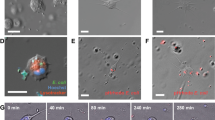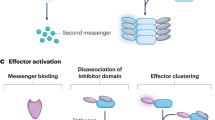Abstract
THE immune mechanisms which enable invertebrates to eliminate infectious agents are not well understood. There have been many reports, however, that invertebrates produce ‘recognition factors’ which interact with foreign substances and subsequently aid the phagocytosis of these substances1–5. Such recognition factors have been isolated from worms, molluscs, arthropods, echinoderms and protochordates, and have been shown to have agglutinating and bactericidal activities as well as opsonic properties. But, unlike the vertebrate immune system, there is little evidence for a memory component in the production of these factors3–5. The recognition factors are usually large molecules which can be readily dissociated into subunits and which in no way resemble the immunoglobulins present in vertebrates3–12. They apparently have specificity for carbohydrate structures and, in many cases, an individual has several distinct subpopulations of recognition factors which bind different sugar specificities3–12. The recognition factors seem to be synthesised by haemocytes in the haemolymph13,14. After secretion they can, in many invertebrate species, bind to the surface of haemocytes as well as persist in a soluble form in the haemolymph3–5,14–18. Both the soluble and cell-bound forms of the recognition factors can augment the phagocytosis of foreign substances. Thus, the invertebrates have evolved a simple recognition system which enables them to discriminate between ‘self’ and ‘non-self’. In this paper I propose that the recognition factors are composed of some of the glycosyl transferases which the invertebrate uses to synthesise its own carbohydrate side chains. Such a model guarantees the maintenance of rigid self non-self discrimination.
This is a preview of subscription content, access via your institution
Access options
Subscribe to this journal
Receive 51 print issues and online access
$199.00 per year
only $3.90 per issue
Buy this article
- Purchase on Springer Link
- Instant access to full article PDF
Prices may be subject to local taxes which are calculated during checkout
Similar content being viewed by others
References
Tripp, M. R. J. Invert. Path. 8, 478–488 (1966).
McKay, D., Jenkin, C. R. & Rowley, D. Aust. J. exp. Biol. med. Sci. 47, 125–134 (1969).
Hildemann, W. H. & Reddy, A. L. Fedn Proc. 32, 2188–2194 (1973).
Cohen, E. & Uhlenbruck, G. (eds) Ann. N.Y. Acad. Sci. 234, (1974).
Cooper, E. L. (ed.) Contemp. Topics Immunobiol. 4, (Plenum New York, 1974).
Cohen, E., Trans. N.Y. Acad. Sci. 30, 427–443 (1968).
Marchalonis, J. J. & Edelman, G. M. J. molec. Biol. 32, 453–465 (1968).
Acton, R. T., Bennett, J. C., Evans, E. E. & Schrohenloher, R. E. J. biol. Chem. 244, 4128–4135 (1969).
Pauley, G. B., Granger, G. A. & Krassner, S. M. J. Invert. Pathol. 18, 207–218 (1971).
Jenkin, C. R. & Hardy, D. Adv. exp. Med. Biol. 64, 55–65 (1975).
Hall, J. L. & Rowlands, D. T. Biochemistry 13, 821–827 (1974).
Hall, J. L. & Rowlands, D. T. Biochemistry 13, 828–832 (1974).
Marck, M. Comp. Biochem. Physiol. 35, 615–622 (1970).
Amirante, G. A. Experientia 32, 526–528 (1976).
Scott, M. T., Immunology 21, 817–828 (1971).
Tyson, C. J. & Jenkin, C. R. Aust. J. exp. Biol. Med. Sci. 52, 341–348 (1974).
Renwrantz, L. R. & Cheng, T. C. J. Invert. Pathol. 29, 88–96 (1977).
Renwrantz, L. R. & Cheng, T. C. J. Invert. Pathol. 29, 97–100 (1977).
Roseman, S. Chem. Phys. Lipids 5, 270–297 (1970).
Karush, F. Ann. N.Y. Acad. Sci. 169, 56–62 (1970).
Evans, E. E. et al. Nature 222, 696–697 (1969).
Evans, E. E., Painter, B., Evans, M. L., Weinheimer, P. & Acton, R. T. Proc. Soc. exp. Biol. Med. 128, 394–398 (1968).
Cooper, E. L. Transplant. Proc. 2, 216–221 (1970).
Duprat, P. C. Transplant. Proc. 2, 222–225 (1970).
Binz, H. & Wigzell, H. Scand. J. Immun. 5, 559–571 (1976).
Shur, B. D. & Roth, S. Biochim. biophys. Acta. 415, 473–512 (1975).
Albersheim, P. & Anderson-Prouty, A. J. A. Rev. Pl. Physiol. 26, 31–52 (1975).
Morell, A. G., Gregoriadis, G., Scheinberg, I. H., Hickman, J. & Ashwell, G. J. biol. Chem. 246, 1461–1467 (1971).
Hudgin, R. & Ashwell, G. J. biol. Chem. 249, 7369–7372 (1974).
Author information
Authors and Affiliations
Rights and permissions
About this article
Cite this article
PARISH, C. Simple model for self-non-self-discrimination in invertebrates. Nature 267, 711–713 (1977). https://doi.org/10.1038/267711a0
Received:
Accepted:
Published:
Issue Date:
DOI: https://doi.org/10.1038/267711a0
This article is cited by
-
Signal minus 1: A key factor in immunological tolerance to tissue‐specific self antigens?
Immunology & Cell Biology (1996)
-
Immunity and inflammation: The cosmic view
Immunology & Cell Biology (1994)
-
Involvement of a maternally transcribed lectin gene in the early development of Bombyx mori
Roux's Archives of Developmental Biology (1994)
Comments
By submitting a comment you agree to abide by our Terms and Community Guidelines. If you find something abusive or that does not comply with our terms or guidelines please flag it as inappropriate.



